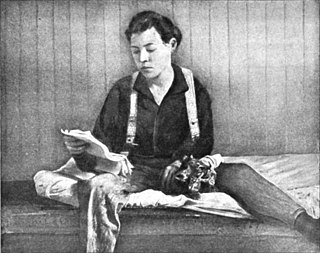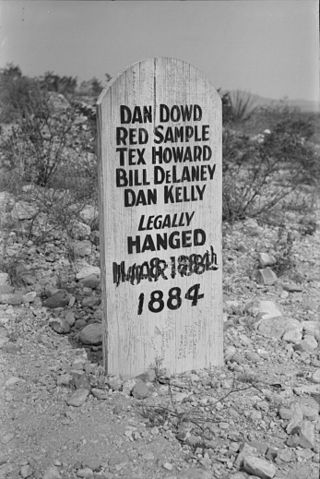Related Research Articles

Since the invention of locomotives in the early 19th century, trains have often been the target of robbery, in which the goal is to steal money or other valuables. Train robbery was especially common during the 19th century and is commonly associated with gangs of outlaws in the American Old West. It has continued into the 21st century, with criminals usually targeting freight trains carrying commercial cargo, or targeting passengers of public transportation for their valuables.

Pearl Hart was a Canadian-born outlaw of the American Old West. She committed one of the last recorded stagecoach robberies in the United States, and her crime gained notoriety primarily because of her gender. Many details of Hart's life are uncertain, with available reports being varied and often contradictory.

Charles E. Boles, also known as Black Bart, was an American outlaw noted for the poetic messages he left behind after two of his robberies. Often called Charley by his friends, he was also known as CharlesBolton. Considered a gentleman bandit with a reputation for style and sophistication, he was one of the most notorious stagecoach robbers to operate in and around Northern California and Southern Oregon during the 1870s and 1880s.
Pete Spence was a small-time criminal known for his association with outlaw Cowboys Frank and Tom McLaury, and Ike and Billy Clanton, of Tombstone, Arizona Territory. Spence was also a suspect in the assassination of Morgan Earp. His wife Marietta Duarte testified that Spence and several friends had talked about killing Morgan, but the judge ruled her testimony inadmissible. Spence was first suspected of robbery in 1878 in Goliad County, Texas. He was suspected of stealing mules and later a suspect in a stagecoach robbery outside Bisbee, Arizona. While a deputy sheriff, he pistol-whipped and killed a man for which he served 18 months of a five-year term before the governor pardoned him.

John Philip Clum was an Indian agent for the San Carlos Apache Indian Reservation in the Arizona Territory. He implemented a limited form of self-government on the reservation that was so successful that other reservations were closed and their residents moved to San Carlos. Clum later became the first mayor of Tombstone, Arizona Territory, after its incorporation in 1881. He also founded the still-operating The Tombstone Epitaph on May 1, 1880. He later served in various postal service positions across the United States.

Frank C. Stilwell was an outlaw Cowboy who killed at least two men in Cochise County during 1877–82. Both killings were considered to have been self-defense. For four months he was a deputy sheriff in Tombstone, Arizona Territory for Cochise County Sheriff Johnny Behan. Stilwell owned interests in several mines and various businesses, including a saloon, a wholesale liquor business, a stage line, and at his death livery stables in Charleston and Bisbee. He was also a partner in a Bisbee-area saloon with ex-Texas Ranger Pete Spence.

The Wham Paymaster robbery was an armed robbery of a United States Army paymaster and his escort on May 11, 1889, in the Arizona Territory. Major Joseph W. Wham was transporting a payroll consisting of more than US$28,000 in gold and silver coins from Fort Grant to Fort Thomas when he and his escort of eleven Buffalo Soldiers were ambushed. During the attack, the bandits wounded eight of the soldiers, forced them to retreat to cover and stole the payroll.

Tom McLaury was an American outlaw. He and his brother Frank owned a ranch outside Tombstone, Arizona, Arizona Territory during the 1880s. He was a member of a gang of outlaws and cattle rustlers called the Cowboys that had ongoing conflicts with lawmen Wyatt, Virgil, and Morgan Earp. The McLaury brothers repeatedly threatened the Earps because they interfered with the Cowboys' illegal activities. On October 26, 1881, Tom and Frank were both killed in the Gunfight at the O.K. Corral in Tombstone, Arizona Territory. The Tombstone shootout was his only gunfight.

Codrington is a rural locality on Portland Bay in the south-west of Victoria, Australia, on the Princes Highway between Portland and Port Fairy. It is a sparsely populated area; at the 2016 census the district had a population of 52 persons, living in 15 dwellings.
The El Paso and Southwestern Railroad began in 1888 as the Arizona and South Eastern Railroad, a short line serving copper mines in southern Arizona. Over the next few decades, it grew into a 1200-mile system that stretched from Tucumcari, New Mexico, southward to El Paso, Texas, and westward to Tucson, Arizona, with several branch lines, including one to Nacozari, Mexico. The railroad was bought by the Southern Pacific Railroad in 1924 and fully merged into its parent company in 1955. The EP&SW was a major link in the transcontinental route of the Golden State Limited.

The Cochise County Cowboys is the modern name for a loosely associated group of outlaws living in Pima and Cochise County, Arizona in the late 19th century. The term "cowboy", as opposed to "cowhand," had only begun to come into wider usage during the 1870s. In that place and time, "cowboy" was synonymous with "cattle rustler". Such thieves frequently rode across the border into Mexico and stole cattle from Mexican ranches that they then drove back across the border to sell in the United States. Some modern writers consider them to be an early form of organized crime in America.

Cochise County in southeastern Arizona was the scene of a number of violent conflicts in the 19th-century and early 20th-century American Old West, including between white settlers and Apache Indians, between opposing political and economic factions, and between outlaw gangs and local law enforcement. Cochise County was carved off in 1881 from the easternmost portion of Pima County during a formative period in the American Southwest. The era was characterized by rapidly growing boomtowns, the emergence of large-scale farming and ranching interests, lucrative mining operations, and the development of new technologies in railroading and telecommunications. Complicating the situation was staunch resistance to white settlement from local Native American groups, most notably during the Apache Wars, as well as Cochise County's location on the border with Mexico, which not only threatened international conflict but also presented opportunities for criminal smugglers and cattle rustlers.

Charles A. Shibell was a teamster, miner, hotel owner, customs inspector, recorder, and Pima County, Arizona County Sheriff and a contemporary of Wyatt Earp and his brothers. Shibell promised a job as Deputy Sheriff to Earp, but when Earp announced his support for Bob Paul as the next sheriff, Shibell appointed Earp's antagonist Johnny Behan to the position instead.

The Skeleton Canyon shootout was a gunfight on August 12, 1896, between members of the High Five Gang and a posse of American lawmen. Following a failed robbery on August 1 of the bank in Nogales, Arizona, the High Fives headed east and split up. The gang's leader, Black Jack Christian, and George Musgrave got away.

The Bisbee massacre occurred in Bisbee, Arizona, on December 8, 1883, when six outlaws who were part of the Cochise County Cowboys robbed a general store. Believing the general store's safe contained a mining payroll of $7,000, they timed the robbery incorrectly and were only able to steal between $800 and $3,000, along with a gold watch and jewelry. During the robbery, members of the gang killed five people, including a lawman and a pregnant woman. Six men were convicted of the robbery and murders. John Heath, who was accused of organizing the robbery, was tried separately and sentenced to life in prison. The other five men were convicted of murder and sentenced to hang.

Boothill Graveyard is a small graveyard of at least 250 interments located in Tombstone, Cochise County, Arizona. Also known as the "Old City Cemetery", the graveyard was used after 1883 only to bury outlaws and a few others. It had a separate Jewish cemetery, which is nearby.

Crawley P. Dake was a lawman and business owner best known for having served as the U.S. Marshal for the Arizona Territory from 1878 to 1882, during a time of notorious lawlessness in frontier towns like Tombstone. A veteran of the American Civil War, Dake was noted for his creativity and for his frequent deputizing of civilian posses after the Posse Comitatus Act of 1878 was passed.

John Foley was a bushranger and associate of Fred Lowry. In July 1863 they robbed several mail coaches, including the Mudgee mail robbery which netted £5,700 in bank-notes. Foley was captured several weeks later with bank-notes from the Mudgee mail in his possession. He was tried at Bathurst and sentenced to fifteen-years hard labour. Foley was released in 1873; he settled in the Black Springs district near Oberon and led a respectable life until his death in 1891.

Anton Mazzanovich (1860-1934) was a Dalmatian-American soldier and author of real stories of the Wild West. Mazzanovich's work is from a perspective of a participant, an eyewitness and a connoisseur of the Wild West having personal knowledge of the individuals he personally met and wrote about. Mazzanovich's books can be classified as historical narratives or memoirs as opposed to short story fiction or novels. The Mazzanovich papers are archived at the Arizona Historical Society, South Arizona Division in Tucson, Arizona.
References
- ↑ Arizona citizen., August 30, 1878, Image 2; repeated in "The True Northerner" Oct 11, 1878 Paw Paw, MI; "The new North-West" {Deer Lodge MT} and "Vermont Phoenix" {Brattleboro, VT} October 18, 1878
- ↑ Bisbee daily review., August 03, 1902, Image 6
- ↑ Bisbee daily review., August 03, 1902, Image 6
- ↑ The Weekly Arizona Miner, August 23, 1878, Image 3
- ↑ Arizona citizen., August 30, 1878, Image 1
- ↑ Daily Los Angeles herald [microform]., August 30, 1878, Image 4
- ↑ Salt River herald., August 31, 1878, Image 1
- ↑ Salt River herald., August 31, 1878, Image 1
- ↑ Arizona citizen., May 05, 1877, Image 2 Chronicling America website accessed September 22,2018
- ↑ Arizona Citizen October 6, 1877 image 3
- ↑ Arizona citizen., September 29, 1877, Image 2
- ↑ Daily Alta California, Volume XXX, Number 10365, 28 August 1878
- ↑ Las Vegas Gazette June 1, 1878 quoting the newspaper "New Mexican" which names Hathaway as the clerk
- ↑ New York "The Sun" June 25, 1878 which names West as the Clerk
- ↑ Arizona Citizen August 2, 1878
- ↑ Arizona Citizen August 23, 1878
- ↑ Arizona citizen., August 16, 1878, Image 3
- ↑ Journal of the West, Vol. 56, no. 1
- ↑ Arizona Citizen August 23, 1878